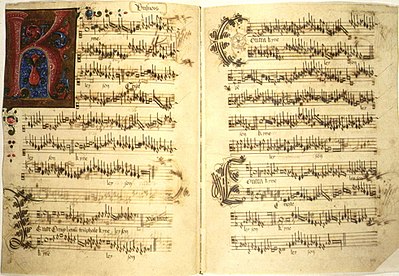Antoine Busnois

Antoine Busnois (pronounce "AN-twun bew-NWAH") (also spelt Busnoys) (born about 1430; died 6 November 1492) was a French composer and poet of the early Renaissance Burgundian School. He wrote church music, such as motets, as well as secular (non-religious) chansons. He was the most important composer of the late Burgundian school after the death of Guillaume Dufay.
Life
[change | change source]We do not know where Busnois was born. It might have been in the tiny village of Business in the Artois district. Maybe he took his name from the village.
Nothing is known about his musical education. We know that he got into trouble in 1461 because he was said to be in a group of people who beat up a priest on five occasions. At that time he was a chaplain in Tours cathedral. While the attack was being investigated he went to mass. This led to him being excommunicated, but later the pope pardoned him.
In 1465 he moved from the cathedral to the collegiate church of St. Martin, also in Tours, where he became a subdeacon. Johannes Ockeghem was treasurer there, and the two composers seem to have known each other well. Later in 1465 Busnois moved to Poitiers, where he not only became "maîtrise" (master of the choirboys), but managed to get lots of good singers from the region. By this time he was famous as a singing teacher and composer. However he left the job for some reason in 1466 and then moved to Burgundy.
By 1467 Busnois was a composer at the court of Burgundy. Soon Charles the Bold was on the throne. Charles fought many wars, and sometimes took Busnois and other musicians on his military journeys. In 1477 Charles was killed at the Battle of Nancy. Busnois continued to work for the Burgundian court until 1482. Nothing is known about what he did after that. He died in 1492.
His music
[change | change source]He was very well known as a composer and his music was sung in many parts of Europe. He was the probably the best-known musician in Europe between the time of Guillaume Dufay and Johannes Ockeghem.
Busnois wrote sacred and secular music. It is likely that a lot of his music is now lost. Two of his masses and eight motets have survived. The style of his music is somewhere between the simple homophonic music of Dufay and Binchois, and the more elaborate imitation of Josquin..
Busnois may have been the composer of the famous tune L'homme armé, one of the most popular tunes of the Renaissance. The tune was often used as a cantus firmus for mass composition. He may have been the very first composer to write a mass based on L'homme armé. This mass was a big influence on many composers.
Busnois is remembered today for many of his chansons (French secular songs). Some of the tunes were used by later composers in their masses.
